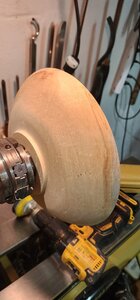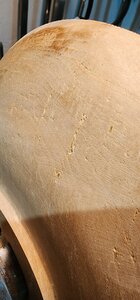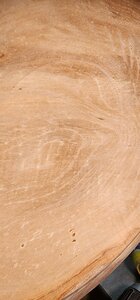I have rough turned some maple which is pretty punky in spots. Have tried stabilizing prior to second turning with PC wood stabilizer but I seem to be turning through the stabilized portion. Thought I would try using a thinned epoxy resin after the second turning and then sanding smooth. Any thoughts or suggestions would be appreciated. Do not want to go the vacuum route. I know I could finish it as is with character, but would like to have a smoother finish
-
May 2025 Turning Challenge: Long Neck Hollowform! (click here for details) -
Congratulations to Phil Hamel winner of the April 2025 Turning Challenge (click here for details) -
Congratulations to Dion Wisniewski for "Basketweave" being selected as Turning of the Week for 12 May, 2025 (click here for details) -
Welcome new registering member. Your username must be your real First and Last name (for example: John Doe). "Screen names" and "handles" are not allowed and your registration will be deleted if you don't use your real name. Also, do not use all caps nor all lower case.
You are using an out of date browser. It may not display this or other websites correctly.
You should upgrade or use an alternative browser.
You should upgrade or use an alternative browser.
When to stabilize punky wood
- Thread starter Bob Uhle
- Start date
I would turn it to within a quarter to a eighth inch of finished thickness then use the penetrating stabilizing finishes. Have to leave just enough to clean up the tearout.
I like this idea. So a 10 inch bowl, rough turn to 1 inch, then dry and second turn to maybe half inch, stabilize and then final turn to my final 3/8 inch thickness. I have tried the PC wood stabilizer, but results are ? Any thoughts on thinned epoxy as stabilizer?
- Joined
- Apr 27, 2004
- Messages
- 9,180
- Likes
- 5,808
- Location
- Lakeland, Florida
- Website
- www.hockenberywoodturning.com
What I do on slightly punky wood is
I first try wetting the surface with water this often swells the fibers and yields a better cut.
if that doesn’t work I used a 1 pound cut of shellac ( 2x the alchohol) this penetrates and fills the spaces between the fibers and give a better cut. Thin lacquer can do similar. The shellac and thin lacquer dry it a few minutes.
I find a pull cut with an Ellsworth ground gouge gives the best surface.
Another coat of thin shellac
Then shear scrape if it improves the surface.
I first try wetting the surface with water this often swells the fibers and yields a better cut.
if that doesn’t work I used a 1 pound cut of shellac ( 2x the alchohol) this penetrates and fills the spaces between the fibers and give a better cut. Thin lacquer can do similar. The shellac and thin lacquer dry it a few minutes.
I find a pull cut with an Ellsworth ground gouge gives the best surface.
Another coat of thin shellac
Then shear scrape if it improves the surface.
My dad was known for his epoxy finishing technique and would use it to stabilize punky/soft wood. I am attaching two documents of his. One goes into detail for his epoxy finishing. Hope these help. Good luck!
Attachments
Thanks for sharing this. I love that your Dad wrote out his techniques and thoughts on this. Used it as a guide on a very punky spalted maple bowl today. Worked well on the outer surface but I turned too deep on the inner side past where the epoxy stabilization ended. Definitely a learning curve. Hopefully will get this right in the next couple of bowls. Love the challenge of this beautiful, but punky wood.My dad was known for his epoxy finishing technique and would use it to stabilize punky/soft wood. I am attaching two documents of his. One goes into detail for his epoxy finishing. Hope these help. Good luck!
Glad it worked at least partially. What epoxy did you use?Thanks for sharing this. I love that your Dad wrote out his techniques and thoughts on this. Used it as a guide on a very punky spalted maple bowl today. Worked well on the outer surface but I turned too deep on the inner side past where the epoxy stabilization ended. Definitely a learning curve. Hopefully will get this right in the next couple of bowls. Love the challenge of this beautiful, but punky wood.
I used a 10 min epoxy. I get impatient sometimesGlad it worked at least partially. What epoxy did you use?
will read and thank you! Does dad have other reviews/suggestions?
I've used shellac and two part epoxy before but recently been using Minwax wood hardener. Easy to find at local HW stores, cures quickly enough to work with on small or large areas and seems to really soak in but not create a mess. I don't try to stabilize after the first turn for twice turned pieces. Like Gary, on the second turn I try to get close to finish shape and thickness then apply the hardener/stabilizer. Then very light, careful, sharp tool cuts to get to final. I may go back more times in specific areas with the stabilizer as needed. It can vary but often a NR scraper on punky areas that have been treated can produce a smooth surface.



